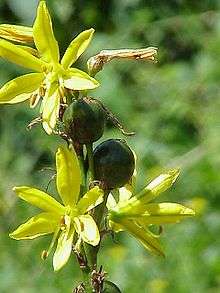Asphodeline lutea
Asphodeline lutea (king's spear, yellow asphodel) is a perennial plant native to southeastern Europe, northern Africa, the Caucasus and the Levant.[1] It is grown as a landscaping plant.[2]
| Asphodeline lutea | |
|---|---|
 | |
| Scientific classification | |
| Kingdom: | Plantae |
| Clade: | Tracheophytes |
| Clade: | Angiosperms |
| Clade: | Monocots |
| Order: | Asparagales |
| Family: | Asphodelaceae |
| Subfamily: | Asphodeloideae |
| Genus: | Asphodeline |
| Species: | A. lutea |
| Binomial name | |
| Asphodeline lutea (L.) Rchb. | |
| Synonyms[1] | |
|
Asphodelus luteus L. | |

It has been associated with the Asphodel of the underworld,[3] but see also the closely related Asphodelus ramosus.
Description
Asphodeline lutea reaches 3 to 4 ft (0.91 to 1.22 m) tall and 1 to 2 ft (0.30 to 0.61 m) wide. The grey-green leaves are 1 ft (0.30 m) tall, with the flower stalk growing 3 to 4 ft (0.91 to 1.22 m) bearing a dense raceme of bright 1 in (2.5 cm) yellow flowers.[2]
History
Asphodeline lutea was introduced into the University of Oxford Botanic Garden in 1648, even though it demonstrated no known uses that are typical of a physic garden (plants grown for medicinal use). One of the curators of the garden at the time, John Parkinson, said the plant was "not... used in Physicke for any purpose." The locals in the Mediterranean who were interviewed by Parkinson said that that plant had "no... propertie appropriate unto it but knavery," with no explanation of the particular knavery of which the plant was guilty. The description in the Botanic Garden used the old name of Asphodelus lutea.[4]
References
- Kew World Checklist of Selected Plant Families
- "Asphodeline lutea". Missouri Botanical Garden. Retrieved 4 September 2012.
- Robert Graves. The Common Asphodel 1949
- "Asphodeline lutea". Botanic Garden. University of Oxford. Archived from the original on 13 April 2015. Retrieved 4 September 2012.